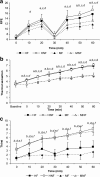Effects of heat stress and dehydration on cognitive function in elite female field hockey players
- PMID: 29946473
- PMCID: PMC6007074
- DOI: 10.1186/s13102-018-0101-9
Effects of heat stress and dehydration on cognitive function in elite female field hockey players
Abstract
Background: It has previously been suggested that heat exposure and hypohydration have negative effects on cognitive performance, which may impact upon sporting performance. The aim of the present study was to examine the independent effects of heat stress and hypohydration on cognitive performance in elite female field hockey players.
Methods: Eight unacclimatised elite field hockey players (age: 22 ± 3 y; height: 1.68 ± 0.05 m; body mass: 63.1 ± 6.0 kg) completed a cognitive test battery before and after 50 min of field hockey specific exercise on a treadmill in four experimental trials; two in hot conditions (33.3 ± 0.1 °C), and two in moderate (16.0 ± 3.0 °C), both with and without ad libitum water intake.
Results: On the visual search test, participants were faster overall in the heat (1941 vs. 2104 ms, p = 0.001). Response times were quicker in the heat on the Sternberg paradigm (463 vs. 473 ms, p = 0.024) and accuracy was improved (by 1.9%, p = 0.004). There was no effect of hydration status on any of the markers of cognitive function.
Conclusions: Overall, the findings suggest that in elite field hockey players exposure to heat enhances response times and/or accuracy on a battery of cognitive function tests. However, hypohydration does not appear to affect cognitive performance in elite field hockey players.
Keywords: Cognitive performance; Decision-making; Hypohydration; Intermittent exercise; Skill; Team sports.
Conflict of interest statement
All participants provided their written informed consent for this study, which was approved by Nottingham Trent University’s Ethical Advisory Committee.Not applicable.The authors declare that they have no competing interests.Springer Nature remains neutral with regard to jurisdictional claims in published maps and institutional affiliations.
Figures




Similar articles
-
Previous-day hypohydration impairs skill performance in elite female field hockey players.Scand J Med Sci Sports. 2012 Jun;22(3):430-8. doi: 10.1111/j.1600-0838.2010.01230.x. Epub 2010 Oct 25. Scand J Med Sci Sports. 2012. PMID: 20973829
-
Efficacy of Hot Yoga as a Heat Stress Technique for Enhancing Plasma Volume and Cardiovascular Performance in Elite Female Field Hockey Players.J Strength Cond Res. 2018 Oct;32(10):2878-2887. doi: 10.1519/JSC.0000000000002705. J Strength Cond Res. 2018. PMID: 29979281
-
Fitness Characteristics of Elite and Subelite Male Ice Hockey Players: A Cross-Sectional Study.J Strength Cond Res. 2019 Sep;33(9):2352-2360. doi: 10.1519/JSC.0000000000003285. J Strength Cond Res. 2019. PMID: 31343551
-
Effects of hypohydration and fluid balance in athletes' cognitive performance: a systematic review.Afr Health Sci. 2022 Mar;22(1):367-376. doi: 10.4314/ahs.v22i1.45. Afr Health Sci. 2022. PMID: 36032481 Free PMC article.
-
Physiology applied to field hockey.Sports Med. 1992 Jul;14(1):10-26. doi: 10.2165/00007256-199214010-00002. Sports Med. 1992. PMID: 1641540 Review.
Cited by
-
The effect of a combined cooling intervention on cognitive function in the heat during an intermittent running protocol.Eur J Sport Sci. 2024 Sep;24(9):1287-1301. doi: 10.1002/ejsc.12178. Epub 2024 Aug 8. Eur J Sport Sci. 2024. PMID: 39117584 Free PMC article. Clinical Trial.
-
Risk of Dehydration Due to Sweating While Wearing Personal 2 Protective Equipment in COVID-19 Clinical Care: A Pilot Study.Healthcare (Basel). 2022 Jan 29;10(2):267. doi: 10.3390/healthcare10020267. Healthcare (Basel). 2022. PMID: 35206881 Free PMC article.
-
Effects of heat strain on cognitive function among a sample of miners.Appl Ergon. 2022 Jul;102:103743. doi: 10.1016/j.apergo.2022.103743. Epub 2022 Mar 18. Appl Ergon. 2022. PMID: 35313260 Free PMC article.
-
Hypohydration alters pre-frontal cortex haemodynamics, but does not impair motor learning.Exp Brain Res. 2022 Sep;240(9):2255-2268. doi: 10.1007/s00221-022-06424-5. Epub 2022 Jul 26. Exp Brain Res. 2022. PMID: 35881154 Free PMC article. Clinical Trial.
-
Different Amounts of Water Supplementation Improved Cognitive Performance and Mood among Young Adults after 12 h Water Restriction in Baoding, China: A Randomized Controlled Trial (RCT).Int J Environ Res Public Health. 2020 Oct 24;17(21):7792. doi: 10.3390/ijerph17217792. Int J Environ Res Public Health. 2020. PMID: 33114364 Free PMC article. Clinical Trial.
References
-
- Starkes JL. Skill in field hockey - the nature of the cognitive advantage. J Sport Exercise Psy. 1987;9(2):146–160.
LinkOut - more resources
Full Text Sources
Other Literature Sources

